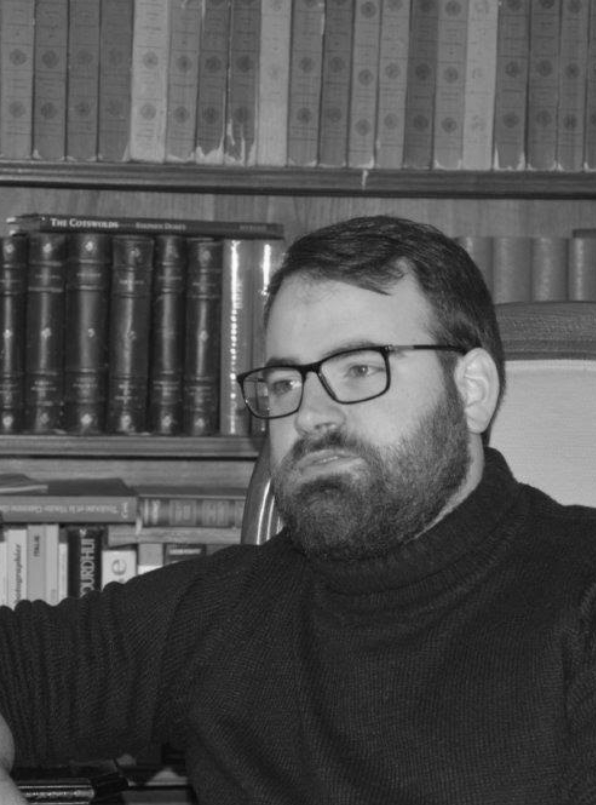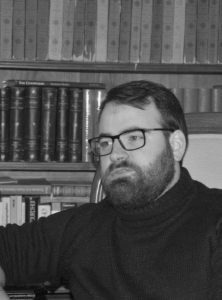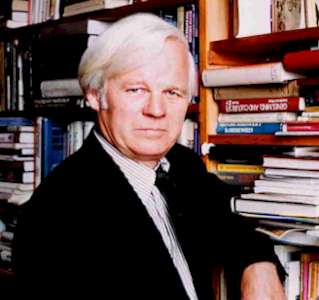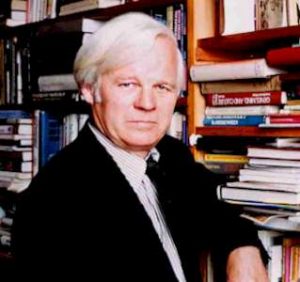
Aurelio José Figueredo is a Cuban-American evolutionary psychologist. He is a Professor of Psychology, Family Studies and Human Development at the University of Arizona, where he is also the director of the Ethology and Evolutionary Psychology Laboratory. He has also been a long-time member of the interdisciplinary Center for Insect Science at the University of Arizona, which has regrettably been closed just this past month. His major areas of research interest are the evolutionary psychology and behavioral development of life history strategy, cognition, sex, and violence in human and nonhuman animals, and the quantitative ethology and social development of insects, birds, and primates.
Grégoire Canlorbe: You are notably known for your research on personality in nonhuman primates (including monkeys and chimpanzees). The Hominoid Personality Questionnaire was used as a quantifier of the big five personality traits in chimpanzees. May you start by telling us more about it?
Aurelio José Figueredo: To be clear, the research on stumptail macaques, published in 1995, used a different list of behavioral traits that had been developed by Stevenson-Hinde, & Zunz (1978). The Hominoid Personality Questionnaire was used for our study of personality in chimpanzees in 1997, and was later extended to other Great Apes. That is an important distinction because the findings of these two studies were different. The Great Apes all showed human-like personality structures resembling the human “Big Five”, although to varying degrees. The macaque monkeys showed a simpler pattern of three major factors, but whether this was a result of differences in the list of items used is unclear.
Figueredo, A.J., Cox, R.L., & Rhine, R.J. (1995). A generalizability analysis of subjective personality assessments in the Stumptail macaque and the Zebra finch. Multivariate Behavioral Research, 30(2), 67-197.
King, J.E., & Figueredo, A.J. (1997). The five-factor model plus dominance in chimpanzee personality. Journal of Research in Personality, 31, 271-271.
Grégoire Canlorbe: A controversial hypothesis by J. Philippe Rushton is that fast life history—including traits like psychopathy—and a healthy, powerful mind, which is high in g, are negatively correlated at the individual level. Do you believe such correlation is indeed displayed—from lower animals to the most sophisticate of mammals?
Aurelio José Figueredo: There is something that we have called “The Rushton Paradox”. On an individual-differences level, at least two meta-analyses (Woodley, 2011; Figueredo et al., 2014) have found weak and trivially small correlations between life history speed and general intelligence. On the other hand, at the aggregate level of human social groupings or biogeographical regions, there is a strong positive correlation between slower life history strategies and aggregate cognitive abilities (e.g., Figueredo, Hertler, & Peñaherrera-Aguirre, 2020). This paradox was resolved by modeling the evolution of higher levels of aggregate intelligence as an emergent property of social groups rather than an individual-level adaptation (e.g., Figueredo et al., 2017).
In the 2017 paper that I cited, the one we called “Plants, Parasites, and People,” we constructed a model, which is a multiple-stage ”Cascade Model”, that slow life history, first of all, is attributable to ecological factors; that we have warmer and wetter climate as well as higher parasite loads predicting human life history speed. Then, life history predicts a variety of other things in sequence before we get to intelligence. For example, slow life history people are generally more cooperative—they have less crime and conflict within their groups. So it creates a more cooperative society. And what we found out in other publications that I didn’t cite, but that I can send you, is that they are more strategically differentiated. They’re more diverse, both in their cognitive abilities and their life history strategies. Those are called the cognitive and strategic differentiation effort hypotheses. What that cognitive and strategic diversification leads to is macroeconomic diversification where the society becomes, first of all, more productive as per Ricardo’s Law of Comparative Advantage: there’s a higher economic productivity consequent to having a greater degree of specialization and trade between the different specialists. It boosts the productivity of a society, and we use various indicators of macroeconomic diversification in that paper. And we show that the intelligence of a slow life history population is elevated indirectly, through this macroeconomic diversification, increasing their aggregate wealth, and thereby indirectly increasing their human capital.
Now see: once you increase your human capital, that leads to gains in IQ. But this kind of thing is called an emergent property of social groups, so that an individual can have individual traits like extraversion, or weight, or height, or anything like that, but an individual can’t have something like macroeconomic diversification all by himself or herself. That is not a property at an individual level. That is a property of an aggregate economy. For example, I can’t have inflation. I can live in a society that has inflation, and I can be affected by inflation; but I don’t personally have an inflation rate, per se. Similarly, macroeconomic diversification is something that only exists at the aggregate level, and it is produced indirectly by a population’s aggregate slow life history. Once you have that, it has the effect, and we documented that in this paper, of increasing the cranial capacity and the intelligence of the population. And that was our explanation of the Rushton paradox because it wasn’t just in one study. In study after study after study, the relationship between individual level IQ and individual level life history is trivially small. It’s extremely small, in many cases, not statistically significant.
Actually, J. Philippe Rushton, who passed away in 2012, is one of the people who were somewhat resistant to the results of such analyses. But this is what you get, like it or not. So, on an individual level, Phil Rushton was wrong. Now, I’m not saying this to bash Rushton. He was a very good friend. And I agreed with him on many things, but there are other things that we frankly argued about in a friendly way because we were friends for years. And we would argue—I’m sure you argue with your friends, that happens. And there are points of contention between you. There is virtually no empirically-validated relation between individual IQ and individual life history strategy. But at the aggregate level, there is a very strong relation. And I sent you a couple of papers that show that between aggregate intelligence and aggregate life history. And that is the answer to the Rushton paradox. At least, that’s the answer that our group has proposed. As far as I know, nobody else would propose any solution to this paradox because most people are not even aware that there’s a paradox. But that is my answer to that question.
Woodley, M. A. (2011). The cognitive differentiation–integration effort hypothesis: a synthesis between the fitness indicator and life history models of human intelligence. Review of General Psychology, 15, 228–245
Figueredo, A.J., Wolf, P.S.A., Olderbak, S.G., Gladden, P.R., Fernandes, H.B.F., Wenner, C., Hill, D., Andrzejczak, D.J., Sisco, M.M., Jacobs, W.J., Hohman, Z.J., Sefcek, J.A., Kruger, D., Howrigan, D.P., MacDonald, K., & Rushton, J.P. (2014). The psychometric assessment of human life history strategy: A meta-analytic construct validation. Evolutionary Behavioral Sciences, 8(3), 148-185.
Figueredo, A.J., Cabeza de Baca, T., Black, C.J., Garcia, R.A., Fernandes, H.B.F., Wolf, P.S.A., & Woodley of Menie, M.A. (2015). Methodologically Sound: Evaluating the psychometric approach to the assessment of human life history [Reply to Copping, Campbell, and Muncer, 2014]. Evolutionary Psychology, 13(2), 299-338.
Figueredo, A.J., Cabeza de Baca, T., Fernandes, H.B.F., Black, C.J., Peñaherrera-Aguirre, M., Hertler, S.C., Garcia, R., Meisenberg, G., & Woodley, M.A. (2017). A sequential canonical cascade model of social biogeography: Plants, parasites, and people. Evolutionary Psychological Science, 3(1), 40-61. DOI 10.1007/s40806-016-0073-5
Figueredo, A.J., Hertler, S.C , & Peñaherrera-Aguirre, M. (2020). The biogeography of human diversity in cognitive ability. Evolutionary Psychological Science, in press.
Grégoire Canlorbe: A fundamental debate in psychology focuses on how knowing whether a certain behavioral pattern that is widespread, if not in all human societies, at least in most human societies (for instance, the prohibition of murder and incest), comes as the fruit of cultural selection. Or, on the contrary, comes as the fruit of genetic selection—whether such pattern was inherited from our primate ancestors or designed in the Pleistocene era (or even later in the course of our species’ biological evolution). As an evolutionary psychologist, what criterion do you resort to when it comes to distinguishing between those of widespread (if not universal) behaviors due to cultural selection; and those due to genetic selection?
Aurelio José Figueredo: The framing of this question presupposes that “cultural selection” and “genetic selection” are two distinct and independent processes. Quite simply put, they are not. Since at least the 1980s, most mainstream theories of human evolution have incorporated the idea of gene-culture coevolution (e.g., Lumsden & Wilson, 1981; Richerson & Boyd, 2005), meaning that genetic changes produce selective pressures for cultural changes, and that cultural changes produce selective pressures for genetic changes. You are correct that genetic selection continued to take place well after what is commonly presupposed to have been either in our distant nonhuman primate ancestors or in our own species during the distant past in the Pleistocene Era. Gene-culture coevolution has continued (and even accelerated) throughout the Holocene (Cochran & Harpending, 2009) and up to and including the Modern Era (Hertler et al., 2020).
One notable example is that of lactose tolerance, the ability of people like you and me to drink cow’s milk in adulthood. Now, all mammals are born with an enzyme called lactase, which digests the milk sugar, lactose, but they only have it for a certain period of time during infancy because mammals only feed on milk during their infancy, and afterwards no longer feed on milk. So, they don’t need the enzyme for lactose after that time. In certain human, not all human populations, but in certain human populations, that created a cultural adaptation because dairy farming is not genetic. They had a cultural innovation for dairy farming, and they substantially enhanced their nutrition and fitness. And as a result of that, those populations evolved what’s called lactase persistence. In medicine it’s called lactose tolerance, but it’s really the persistence of that enzyme into adulthood. It is not distributed evenly throughout the world. Studies have been done, where, according to the archeological record, there has been like 5000 years of dairy farming. So, in those areas, the gene for lactase persistence is highly prevalent. Where there has been very little to no dairy farming, you know, then, lactase persistence is absent. And for a long time in medical circles, this absence was called lactose intolerance and treated as a disorder. Because in societies derived from European or Mediterranean societies, it is rare to be lactose intolerant because everybody digests the milk from cows even as adults. Dairy farming is a clear-cut case of a cultural innovation—because nobody has ever identified a genetic mutation for dairy farming. But wherever dairy farming took place over sufficient evolutionary time, and adults were drinking milk, a genetic mutation followed and spread throughout the population. I said cow’s milk, but it could be sheep’s milk or mare’s milk. It’s believed by some that mare’s milk was the first kind of non-human milk that we started drinking, out in the Eurasian steppes. The proto-Eastern Europeans started doing that thousands of years ago. It is in those populations where that gene is not universal, but it’s highly prevalent because of the fitness advantages of being able to consume the milk of non-human animals even as an adult, even after you are past the breastfeeding period.
Lumsden C., & Wilson, E. O. (1981). Genes, Mind and Culture: The Coevolutionary Process. Cambridge, MA: Harvard University Press.
Richerson, P. J. & Boyd, R. (2005). Not By Genes Alone: How Culture Transformed Human Evolution. University of Chicago Press.
Cochran, G., & Harpending, H. (2009). The 10,000 Year Explosion: How Civilizations Accelerated Human Evolution. New York, NY: Basic Books.
Hertler, S., Figueredo, A.J., & Peñaherrera-Aguirre, M. (2020). Multilevel Selection: Theoretical Foundations, Historical Examples, and Empirical Evidence. New York, NY: Palgrave Macmillan.
Grégoire Canlorbe: Your name is attached to the claim that, instead of religion being the cultural cause of moral intuitions, the association between religiosity and moral intuitions comes as “a spurious correlation” caused by slow life history strategy. How do you develop that insight?
Aurelio José Figueredo: We developed and empirically supported that idea by testing various alternative structural equation models, some of which hypothesized religion as the cause of moral intuitions, and comparing them for best fit to the data that we had collected. The best model, by these empirical criteria, has life history strategy as the common cause of both. Both behavioral traits are thus ultimately reducible to that single biological cause, rather than one psychosocial trait causing the other.
Grégoire Canlorbe: As a proponent of the multilevel selection approach, you probably know E.O. Wilson’s suggestion to leave behind kin selection theory (i.e., the claim that group selection only occurs at the level of groups of kin-related individuals), which he says has been refuted in hymenoptera and a variety of other species (including homo sapiens). Do you believe kin selection, instead of being wholly inoperative, applies in some specific cases? What is your take on E.O. Wilson’s candidate for a more comprehensive model of group selection—namely eusociality?
Aurelio José Figueredo: We do not agree (see Hertler et al., 2020) that kin selection theory has been entirely “refuted” in the Hymenoptera. In fact, we just wrote a recently accepted entry (“Hymenopteran Eusociality”) to the Encyclopedia of Animal Cognition and Behavior on that topic, which I can provide upon request. What has been refuted is the idea that kin selection is the sole selective pressure underlying Hymenopteran eusociality. Other forces have also been conclusively shown to be at work, and kin selection alone is neither a necessary nor sufficient explanation for advanced forms of sociality. In our view, kin selection models have largely been subsumed under more complex models of multilevel selection, only applying to altruistic relations among very close kin. For more diffuse kin networks, such as in human hypersociality among quite distant relatives, or ultrasociality as it is sometimes called (Turchin, 2016), other theories need to be incorporated. The relative degrees of genetic relatedness within-groups and between-groups (as captured in the statistic Fst, for example) is still a cardinal parameter underlying social evolution, but it is not the only consideration. Ecological factors, for example, also feature prominently.
Turchin, P. (2016). Ultrasociety: How 10,000 Years of War Made Humans the Greatest Cooperators on Earth. Chaplin, CT: Beresta.
Grégoire Canlorbe: The cover of your very new collaborative book, Multilevel Selection, reproduces Lionel Royer’s famous painting of Vercingetorix surrendering to Caesar. What did motivate such illustration choice? In group selection and life history terms: how do you explain the West has been unique in producing such a variety of great men (both in history and fiction)? To name but a few, Achilles, Ulysses, Alexander the Great, Sulla, Julius Caesar, Vercingetorix, William the Conqueror, Cesare Borgia, Julius II, Davy Crockett, Rhett Butler, Tony Montana, Frank Castle.
Aurelio José Figueredo: That cover was selected because we wanted to emphasize the continuing importance of competition between groups as a persisting selective pressure in historical populations. That scene was a particularly dramatic one, illustrating a relatively recent outcome of intergroup conflict.
As far as the West producing a disproportionate number of “great men”, I am not really sure that is true. Most of the examples that you give are military leaders. To those, I would retort with Temujin son of Yesugei (the “Genghis Khan”, which was a title, not a proper name), who conquered the largest contiguous land-based empire in human history, and his General Subutai, arguably the greatest military strategist that ever lived! If we are instead talking about spiritual/philosophical leaders, I could counter with the cases of K’ung Fu-Tse (“Confucious”), Lao-Tsu (founder of Taoism), and Prince Siddhartha Gautama (“The Buddha”, founder of the eponymous religious philosophy). In what way are these lesser men than their Western counterparts? I am simply skeptical of the premise behind this particular question.
Grégoire Canlorbe: The fall of the Soviet Union resulted into the ending of the intergroup tournament between America and Russia. How do sum up the Cold War’s intragroup consequences on America’s biocultural fabric? What did happen to the latter once the war was over?
Aurelio José Figueredo: The fall of the Soviet Empire clearly reduced the intergroup selective pressures to which US populations are subjected. Our current conflicts are cases of “asymmetrical warfare” against substantially weaker opponents. There hasn’t been a major war among “Great Powers” for over half a century. Not that I am looking forward to having one, mind you, but it would definitely ratchet up the group-selection pressure, as by providing a true “existential threat”, which the current crop of Jihadis simply do not do, in spite of all the fear-mongering about them. In several of our recent publications, we have documented the decline in group-selected values in “Britannic” populations (meaning the successor states of the British Empire, including the USA) as a direct consequence of the reduced intensity of competition between groups over the Late Modern Era (reviewed in Hertler et al., 2020).
Within our collaborative writing group, including colleagues like Michael A. Woodley of Menie, these group cohesion factors and things like loyalty, altruism, martial valor, self-sacrifice are thought to be group-selected traits that, within the context of a multilevel selection model, have sometimes been able to partially overcome the forces of individual selection, which are disruptive of these traits. They have been able to partially counteract, in certain historical periods, the forces of individual selection, which oppose group cohesion. But this can happen only under conditions of intense inter-group competition. And when that intense inter-group competition declines, for whatever reason, then these traits erode. We have documented this trend during the relatively peaceful and prosperous period that followed the very harsh and conflict-ridden Little Ice Age. The Little Ice Age had raged throughout most of the early modern era, starting in the mid XIV Century, actually early XIV Century. And that was a period of very intense competition, resource scarcity, famine, pestilence, warfare. But the Little Ice Age came to an end at about 1817, and things have been relatively benign since that time, and the prevalence of warfare has substantially decreased. The prevalence of inter-group competition has decreased, generally.
So, we have been trying to frame group selection within a broader historical perspective in that respect. A lot of people don’t get the fact that social conflict has been decreasing over the past couple of centuries—actually, Steven Pinker (2011) wrote about this phenomenon in his own book, that even though millions and millions of people died in World War One and Two, your per capita risk of dying, corrected for the total population size, was much less in those two wars than in most of the wars of the more distant past. The actual per capita rate of war mortality has plummeted. Also, the rate of criminal homicide—the rate at which we kill each other—has declined, and all social competition has been substantially reduced since the end of the Little Ice Age. And as a result, the amount of violence has decreased in European and European-derived populations. But we’ve also—Michael and I—found, for instance, that a lot of these pro-social values, a lot of the idea of sacrifices for the security of the group have been eroding consistently since the 1800s. In fact, we’re just now revising the paper that we recently submitted that show the data for this as well. And we can send you that paper, if you’re interested. But right now, it’s still in the review and revision stage.
The Soviet Union, in my reading of history, was the last great existential threat that the United States faced since the defeat of Germany and Japan in WW2. That was a serious challenge. Had the Germans and the Japanese won WW2, the Anglo-American hegemony that had been exerted over the world since the end of the Napoleonic Wars would have been reversed, and the dominance and hegemony of the Anglo-American, Britannic people would have been essentially broken. Similarly, had the Soviet Union won the Cold War, the same thing would have happened. That was a real threat.
Once the Soviet Union fell, there was virtually no threat from anyone in the world to the global dominance of the Britannic people for a long time. And as a result, we have shown by various types of evidence that their group selected traits and social cohesion have been eroded, and are presently in a state of decay. Now, this may not persist, because some people believe that communist China is going to be the next big threat to this Pax Americana, so to speak. I don’t know enough political science to know whether that’s true or not, but some people are saying that there’s going to be another threat, whether there will be a cold war, or a hot war, or any kind of war is unknown. I have no way to predict that. But if that should happen, you will see a resurgence of this kind of nationalism and this kind of group cohesion in response—with respect to the external threat. But without an external threat, the forces of group selection cannot overcome the forces of individual selection. Individual selection puts a premium on self-interest and not group welfare. And as a result, those are the evolutionary conditions that lead to the proliferation of individually-selected people and the erosion of group cohesion. So, the fall of the Soviet empire was just the latest episode in this process. It may not be the last. I can’t tell the future with any degree of confidence because there are still uncertainties, for example, as to what’s going to happen over time.
Pinker, S. (2011). The better angels of our nature: Why violence has declined. New York, NY: Penguin.
Grégoire Canlorbe: Anthropologist Robert Ardrey did not hesitate to characterize man as a territorial animal, most likely evolved from carnivorous African primates; and not—as was then the scientific consensus—from Asian herbivores. Unless in the case of defensive wars, those intended to expulse one or more intruders, Ardrey nonetheless refused to include war among the manifestations of the territorial imperative. Rather he thought war to fall within cultural selection. Do you follow him on that point—or do you judge war to fall within biological adaptation?
Besides, how do you account for those inter-ethnic differences in territoriality we can witness today? With superorganisms in the West proving prone to tolerating an ever-higher proportion of foreign ethnicities on their soil; and, conversely, those in Asia and Africa exhibiting persistently high levels of territoriality.
Aurelio José Figueredo: First off, Robert Ardrey was not much of an “Anthropologist”: He was primarily a playwright and screenwriter for most of his life (a very good one, in fact!) He then wrote some semi-popular science books to cash in on the then-current fad of writing potboilers based on human evolutionary science and ethology.
Ardrey’s speculations notwithstanding, war is indeed a biological adaptation and is a straightforward manifestation of violent intergroup competition. We see it in many other species besides ourselves, as with many eusocial insects. We also have evidence for the antiquity of warfare in our own species, dating back to prehistoric as well as contemporary pre-state societies (see Keeley, 1996), where it has been present nearly universally. For example, the archeology of the European Neolithic is littered with the mass graves of the defeated, with bones clearly exhibiting signs of violent deaths. Many sites in Africa show similar patterns, so this is not limited to ancestral Europeans. Once again, in response to Ardrey’s position on the matter, recall that cultural and genetic selection are not mutually exclusive nor independent of each other, so his dichotomy there is both useless and obsolete.
With regards to current trends in demographics, I can only speculate. My first reaction is to see how long they last. The “superorganisms in the West” of which you ask might well be in the process of fragmentation as a result of the relaxation of the formerly intense group-selective pressures. However, as you know, in places like France, there is a substantial opposition to this. And in many other countries, there is a substantial reaction to these open immigration policies that they have had. So, I don’t know that that is going to be viable long term, because a lot of the natives have been reacting to this quite strongly. And governments may be pressured to avoid this kind of thing, or at least, to limit the ethnic separatism that is practiced by some of these immigrant communities. For example, you know, I speak a little French—I’ve been to France several times—so I hope you don’t mind if we talk a little bit about the specific example of France. I don’t think any French people, at least none that I know, and I know quite a few of them, object to the Muslims staying in France. They just insist that anyone, whether Muslim or not, has to adapt to French culture, French civilization, if one wants to live in France. You have to speak French, abide by the laws of France, and be a normal citizen of the republic. That’s what French people have told me. It is not that they don’t like Muslims per se, but that the kind of separatist impulses that some of these communities have are objectionable to French nationalism. That’s my understanding.
The idea that incorporating diverse cultural elements within one society is unfeasible, I don’t think that’s completely correct. To wit, if you look at European history, the Roman Empire lasted for over a thousand years, but I’m talking about the Western Empire. If you count the Eastern Empire, the so-called Byzantine Empire, that lasted—their collective existence might be close to two thousand years. Those were empires that, although established by particular ethnic groups (the Romans), ruled over a very multicultural, diverse array of nations, for century after century. And they had a thriving civilization going. Now, were individual ethnic groups pursuing their own self-interest? Of course, they were. You know, everybody pursues their own self-interest, regardless of who it is. So, was there a certain amount of ethnic nepotism among all the groups involved? Absolutely. That’s really what any evolutionist would expect. But does that mean that within an empire, you cannot coexist with these other groups for perhaps centuries, and perhaps even millennia? I would say the history of Europe would answer no, it is not impossible. You can have a multicultural empire that includes a diverse set of ethnicities, provided they are all guided by a common set of laws and principles. In that sense, I completely agree with the French attitude on this matter.
The Romans referred to this principle as Romanitas, or Romanness. And, the law was the law, and it was the law for everybody, and Roman law was strictly enforced. And after a few centuries, everyone in the Empire was granted Roman citizenship. At least, all free persons (not slaves) were granted Roman citizenship. And there were many emperors from Gallia, from Hispania, even some from North Africa that actually became Roman emperors. And they were all incorporated. In fact, there was one semi-popular book I remember called The Celtic Empire, in which the author made the case that Gallia, which is now France, became one of the dominant parts of the Roman Empire after the second century. It was a really critical part of the Empire. The Roman Empire wasn’t just Italians. So, I frankly don’t agree that ethnic homogeneity is absolutely necessary for a functional multinational society or state —what I’m calling an empire regardless of type of government. There have been plenty of examples where that has been made to work. Another example, if you don’t want to think of Rome, is the so-called Inca empire, correctly called Tawantinsuyu, of the Andes in South America. They had a very multicultural empire. However, they had a brilliant road system, just like the Romans, and any province that rebelled or tried to practice separatism was crushed by the imperial army. Rebellion was not tolerated. You had to follow the rules, and you had to actually be part of that Andean state. And if not, there were dire consequences. So, a certain degree of conformity to social norm was enforced both by the Romans and by the Andean people. And they were very good examples of multinational states, multi-ethnic states that lasted with some degree of stability, literally for centuries.
So, even though I’m an evolutionist and yes, genetic relatedness is an important factor in group selection, it is not the only factor. It is not necessarily the predominant one. And it is not strictly necessary, as some theorists have argued. The historical evidence indicates that nationalism, as we know it today, arose in the 19th century. It—that ideology of nationalism—was not even a coherent doctrine in Europe before that. I’m not saying there aren’t some instincts for ethnic nepotism. Those clearly exist in every human group; everywhere, you find ethnic nepotism. But the kind of radical nationalism that Europeans came to accept in the 19th century is a recent historical invention, and it may be degraded over time as a result of these different social realities. I think this phenomenon was actually caused by the imperial expansion of the European powers, the fact that they incorporated ethnically different groups into their empires; often against the objection of the natives, but they incorporated these diverse groups into their societies. So, for example, to use the case of France again, you have a lot of Algerians in France. The Algerians never invaded France. France invaded and conquered Algeria. That’s historical fact. So, we have Algerians now in France. Just understand, you asked for them, right? They did not voluntarily do this. And it’s not just like that in France, but in all the formerly imperial powers. They just incorporated these other people, created worldwide empires and global trade networks. So, that automatically incorporates these people within your society whether you acknowledge it or not.
So, now the question is how to deal with these diverse groups—and how to incorporate them as part of an orderly society. I believe that historical evidence indicates that that is possible. But you cannot tolerate the separatists. This kind of multiculturalism philosophy that’s being preached nowadays, where everybody is just pursuing their own ethnic interests and there’s no loyalty to any kind of higher power, is not feasible in the longer term. But is it possible to create a true multicultural state where everybody engages in a cooperative network and everybody plays by the same rules? I think that historical evidence indicates that yes, it is possible. But you have to be firm. You can’t be weak. Only strong empires can do this.
Keeley, L. H. (1996). War Before Civilization: The Myth of the Peaceful Savage. Oxford University Press
Grégoire Canlorbe: You challenge the idea that interindividual romantic relationships are primarily influenced by communication. You instead suggest that life history strategies in partners serve as the most fundamental force in shaping the outcome of their relationship. May you come back at that issue?
Aurelio José Figueredo: Again, I tend to favor more fundamental and biological explanations to purely psychosocial and behavioral ones. “Communication” is only a proximate cause, whereas life history strategy better specifies the ultimate selective pressures that might have led to that behavior. Specifically, the need for biparental care in species with altricial offspring (such as our own) requires long-term bonding between fathers and mothers for the purpose of raising their offspring. It is that biological function that requires the communication. I am not downplaying the important role of supportive communication in maintaining human romantic relationships, but merely trying to explain why it is there.
Grégoire Canlorbe: Thank you for your time. Do you feel the need to add something?
Aurelio José Figueredo: I should point out that all the work that you have attributed to me was instead the work of many collaborative efforts over the years, and the role that my coauthors have played, as well as the massive contributions that they have made, should not be downplayed. I just wanted to acknowledge that before we finish. The citations provided present only a partial list of those collaborators. I think this was a very good interview, and I thank you for being honest, and as you said, not hostile. I don’t feel on the spot like you’re trying to catch me in something as some interviewers have tried to do in the past. And I appreciate your being open-minded.
That conversation was initially published in The Postil Magazine, in February 2021


 Philippe Fabry is a lawyer and a theorist of history. His approach, which he calls “historionomy,” endeavors to identify the cyclical patterns of history. He authored Rome, from Libertarianism to Socialism, A History of the Coming Century, and The Structure of History. His website is:
Philippe Fabry is a lawyer and a theorist of history. His approach, which he calls “historionomy,” endeavors to identify the cyclical patterns of history. He authored Rome, from Libertarianism to Socialism, A History of the Coming Century, and The Structure of History. His website is: 
 Richard Lynn is an English psychologist and author. A former professor emeritus of psychology at Ulster University and assistant editor of the journal Mankind Quarterly, Prof. Lynn is perhaps the world’s foremost proponent of eugenics. He is also well known for his studies of racial differences in intelligence. Many of his books have been
Richard Lynn is an English psychologist and author. A former professor emeritus of psychology at Ulster University and assistant editor of the journal Mankind Quarterly, Prof. Lynn is perhaps the world’s foremost proponent of eugenics. He is also well known for his studies of racial differences in intelligence. Many of his books have been 
 Michael Anthony Woodley of Menie, Yr. (Younger), is a British ecologist and evolutionary psychologist, whose research on secular trends in different aspects of human intelligence has earned him considerable notability.
Michael Anthony Woodley of Menie, Yr. (Younger), is a British ecologist and evolutionary psychologist, whose research on secular trends in different aspects of human intelligence has earned him considerable notability.